Research and Development of Inland Green and Smart Ship Technologies in China
Abstract
1. Introduction
2. The Current State of China’s Inland Waterways and Ships
- Ships generally have small tonnage, high emissions, and low efficiency.
- There is a lack of smart technology, excessive reliance on the crew, occurrence of many accidents, and poor safety records.
- There is insufficient application of energy-saving and environmental-protection technology, resulting in high energy consumption and poor economic performance.
- Ship technology is old and unable to fully adapt to the current states and development of various aspects of the infrastructure, such as waterways and ports.
3. Current Inland Green and Smart Ship Technology in China
3.1. Inland Ship Technology
3.1.1. Research and Development of Flat Ship Type with Full Form
3.1.2. Maneuverability in Shallow Water
3.1.3. Lightweight Structure
3.1.4. Optimal Engine–Propeller Matching
3.2. Green Ship Technology
3.2.1. Surface Drag Reduction
3.2.2. Direct Current (DC) Networking
3.2.3. Clean Energy and Power
3.2.4. Integration of Energy-Saving Technologies
3.2.5. Cabin Noise Control
3.3. Smart Ship Technology
3.3.1. Smart Information Integration
3.3.2. Smart Engine
3.3.3. Smart Navigation
3.3.4. Smart Energy Efficiency
3.3.5. Smart Hull
3.3.6. Smart Cargo Control
4. Inland Green Smart Test Ship
4.1. Introduction to Test Ship
4.2. Overall Design of Test Ship
4.3. Modular Function Arrangement Optimization
4.4. Design of a Dynamic Test System
4.5. Multi-Level Test Verification
5. Conclusions
Author Contributions
Funding
Institutional Review Board Statement
Informed Consent Statement
Data Availability Statement
Conflicts of Interest
References
- China News. During His Visit to Wuhan, Xi Called for the Yangtze River to Be Turned into a Golden Waterway. Available online: https://www.chinanews.com.cn/gn/2013/07-24/5077997.shtml (accessed on 24 July 2013).
- Yi, X.; Kun, L. Yangtze set to become a “highway on the water”. China Dly. 2018, 8, 6. [Google Scholar]
- Ministry of Industry and Information Technology of the People’s Republic of China. The Smart Ship Development Action Plan (2019–2021) was jointly published by the three department. Ship Stand. Eng. 2019, 52, 4. [Google Scholar]
- Wang, N.; Zhen, X. Present Situation and development trend of ship intelligent manufacturing technology. Ship Eng. 2019, 41, 5–9. [Google Scholar]
- Sohu News. Grab the Unmanned Boat Market! “All over Japan” Ship Enterprises to Promote. Available online: https://www.sohu.com/a/403336306_155167 (accessed on 21 June 2020).
- International Ship Network. South Korea: Based on “Intelligent Self-Navigation Ship” to Win the First Opportunity. Available online: http://www.eworldship.com/html/2019/ShipbuildingAbroad_1120/154560.html (accessed on 20 August 2022).
- Sohu News. Special Attention | Unmanned Ships: The Future Has Arrived. Available online: https://www.sohu.com/a/281842698_120056227 (accessed on 14 December 2018).
- MarineLink. Zero-Emission Vessel Future of The Fjords Delivered. Available online: https://www.marinelink.com/news/zeroemission-delivered436568 (accessed on 19 April 2018).
- Sohu News. Are you Familiar with Typical Cases of Intelligent Navigation of Ships around the World? Available online: https://www.sohu.com/a/441276624_120056227 (accessed on 29 December 2020).
- CCTV News. Ministry of Transport: By 2035, China Will Basically Complete the Construction of “Four Vertical, Four Horizontal and Two Network” National High-Grade Waterways of 25,000 Kilometers. Available online: https://news.cctv.com/2021/06/25/ARTI0qAuZ4l0lXM6kWW4tPdB210625.shtml (accessed on 25 June 2021).
- Jun, C. Yangtze River Ship Wash: Take the problem to change. China Water Transp. 2019, 618, 17–18. [Google Scholar]
- Zou, L. Development status and ship type analysis of river-sea-going transport ship in the Yangtze River. China Water Transp. 2017, 17, 33–34. [Google Scholar]
- Hui, L. Analysis and suggestions on the current situation of smart shipping in the Yangtze River. Sci. Technol. Ports 2020, 52, 42–44. [Google Scholar]
- Yang, W.; Li, M.; Kuang, S. Creating Green transport mode of inland river and promoting high-quality development of water transport. China Strateg. Emerg. Ind. 2021, 24, 11–22. [Google Scholar]
- Pei, Z.; Wu, S.; Wu, W. Key technology of wide, flat and fat river-sea-going multi-purpose ship. China Water Transp. 2016, 37, 11–12. [Google Scholar]
- Pei, Z.; Zhu, Z.; Wu, W. Design on flat-type river-sea-going multi-purpose ship. In Proceedings of the 25th International Ocean and Polar Engineering Conference, Kona, HI, USA, 21–26 June 2015; pp. 1229–1235. [Google Scholar]
- Ifeng News. The Largest Container Ship in China’s Inland Waterways Has Officially Formed a Thousand Container Class Fleet in Wuhan Xingang, China’s First Voyage in Wuhan. Available online: http://hb.ifeng.com/c/84CBlWeQ1qb (accessed on 1 March 2021).
- Sohu News. Yangtze River “Big Mac” Makes Its Maiden Voyage in Wuhan, Ushering in “Thousand Container Era” of Yangtze River Inland Navigation. Available online: https://www.sohu.com/a/276997970_738977 (accessed on 21 November 2018).
- Chen, Q.; Zhang, W.; Zhao, B. Development trend of ship form in the golden channel of the Yangtze River. China Ship Surv. 2015, 6, 94–97. [Google Scholar]
- Wu, G.; Yan, J.; Li, F. Discussion on ship form characteristics and key points of design for river-sea-going ship. Ship Ocean Eng. 2008, 37, 4. [Google Scholar]
- Pei, Z.; Yuan, Q.; Wu, W. Development of “4E” Level River-Sea-Going Ship. Pol. Marit. Res. 2018, 25, 84–90. [Google Scholar] [CrossRef]
- Feng, D.; Ye, H.; Yang, X.; Zhang, Z.; Tao, X. Optimization on the bow of super-shallow draught ships. Shipbuild. China 2009, 50, 180–185. [Google Scholar]
- Pei, Z.; Wu, W.; Wan, H. Research on key technology of energy-saving and environmental protection river-sea-going ship. J. Beibu Gulf Univ. 2020, 35, 1–6. [Google Scholar]
- Zhang, D.; Li, S.; Chen, Z. Pre-turning current method. Shipbuild. China 1998, 142, 16–21. [Google Scholar]
- Shen, A.; Liu, H. Maneuvering performance in the shallow water of large-scale ships. J. Ship Mech. 2009, 13, 727–733. [Google Scholar]
- Pei, Z.; Iijima, K.; Fujikubo, M.; Tanaka, S.; Okazawa, S.; Yao, T. Simulation on progressive collapse behaviour of whole ship model under extreme waves using idealized structural unit method. Mar. Struct. 2015, 40, 104–133. [Google Scholar] [CrossRef]
- Zhang, W.; Liu, G.; Wu, W. Research on wave load of Jianghai navigation bulk carrier. J. Wuhan Univ. Technol. (Transp. Sci. Eng.) 2011, 35, 4. [Google Scholar]
- Kang, Y.; Pei, Z.; Ao, L.; Wu, W. Reliability-Based design optimization of river-sea-going ship based on agent model technology. Mar. Struct. 2024, 94, 103561. [Google Scholar] [CrossRef]
- Song, X.; Yuan, C. Analysis of influence of water flow velocity on energy efficiency of inland river ship operation. Ship Eng. 2016, 7, 54–57. [Google Scholar]
- Yang, X. Design and Synthesis of Nanoporous Materials: Stability of Catalytically Active Sites. Master’s Thesis, Jilin University, Changchun, China, 2007. [Google Scholar]
- Wu, H.; Dong, W.; Ou, Y. Numerical Method Investigation of Drag Reduction with Air Layer at Bottom of Ship. J. Nav. Univ. Eng. 2016, 28, 70–75. [Google Scholar]
- Yang, G.; Mou, Z.; Wu, D. Development advantages of electric propulsion technology for direct current networking of ships. Ship Sci. Technol. 2017, 39, 8–14. [Google Scholar]
- Han, Q.; Zeng, F. Application of Marine electric propulsion system. Transp. Sci. Technol. 2008, 4, 118–120. [Google Scholar]
- Xu, S.; Wu, Y. Comparison of Marine DC networking technology. Ship Sci. Technol. 2016, 38, 60–63. [Google Scholar]
- Weng, S.; Du, P.; Zhang, Y. Research on safety of lithium battery-powered ship. Ship Eng. 2020, 42, 7. [Google Scholar]
- Cao, M.; Cai, G.; Yu, X.; He, J. Temperature field test and calculation of power lithium-ion battery. Battery Bimon. 2020, 50, 4. [Google Scholar]
- Zhang, H. Summary of group technology of marine lithium-ion battery. Mar. Electr. 2020, 40, 5. [Google Scholar]
- Pei, B.; Wang, L.; Yang, D. Numerical simulation of lithium battery thermal management system based on immersion liquid cooling. Mar. Electr. 2020, 40, 1–5. [Google Scholar]
- Ding, Z. Research on EEDI Test and Analysis Method of Inland River Ships. Master’s Thesis, Wuhan University of Technology, Wuhan, China, 2018. [Google Scholar]
- Cao, L. Design and Implementation of Integrated Control System for Marine Power Station. Master’s Thesis, Dalian Maritime University, Dalian, China, 2017. [Google Scholar]
- Zou, M.; He, J.; Yi, K. Control strategy for management system of inland river lithium electric propulsion ship power station. Mar. Electr. Electron. 2019, 39, 8. [Google Scholar]
- Yang, D.; Yu, Y. Development of integrated software for evaluation of ship vibration and cabin noise. Comput. Aided Eng. 2019, 25, 8. [Google Scholar]
- Wang, X.; Xu, R.; Qi, Q.; Yu, M.; Wu, W. Research on Vibration and Acoustic Characteristics of Underwater Composite Shell Structure. In Proceedings of the 15th Symposium on Ship Underwater Noise, Zhengzhou, China, 1 August 2015; pp. 84–89. [Google Scholar]
- CCS. Rules for Intelligent Ships; China Classification Society: Nanjing, China, 2020. [Google Scholar]
- Wang, Q.; Wang, X.; Ma, C. Design and implementation of inland water ship intelligent navigation system. World Shipp. 2015, 38, 5. [Google Scholar]
- Yao, J. Intelligent ship system based on wireless sensor network. Electron. World 2013, 1, 81–82. [Google Scholar]
- Lu, T.; Huang, Z.; Wang, J. Analysis of health condition assessment method for intelligent marine engine and pump room equipment. China Shiprep. 2020, 33, 3. [Google Scholar]
- Zhang, B.; Zhang, Y.; Wang, X. Research on key technologies of ship intelligent navigation and control based on ship-shore coordination. China Basic Sci. 2021, 23, 44–51. [Google Scholar]
- Li, Y.; Zhang, R.; Wei, M. Current situation and prospect of research on key technologies of ship autonomous navigation. Chin. J. Ship Res. 2021, 16, 32–44. [Google Scholar]
- Wang, K.; Hu, W.; Huang, L. Present Situation and prospect of research on key technologies of ship intelligent energy efficiency optimization. Chin. J. Ship Res. 2021, 16, 13. [Google Scholar]
- Ke, Z.; Qi, D. Design of ship intelligent energy efficiency management system. Ship Sci. Technol. 2020, 42, 143–147. [Google Scholar]
- Shan, Y.; Ma, Z.; Zeng, X. Research on structural deformation estimation method based on distributed optical fiber sensing technology. Chin. J. Sci. Instrum. 2021, 42, 1–9. [Google Scholar]
- Yan, X.; Wang, S.; Ma, F. Current research situation and development thinking of intelligent cargo ship. Chin. J. Ship Res. 2021, 16, 1–6. [Google Scholar]
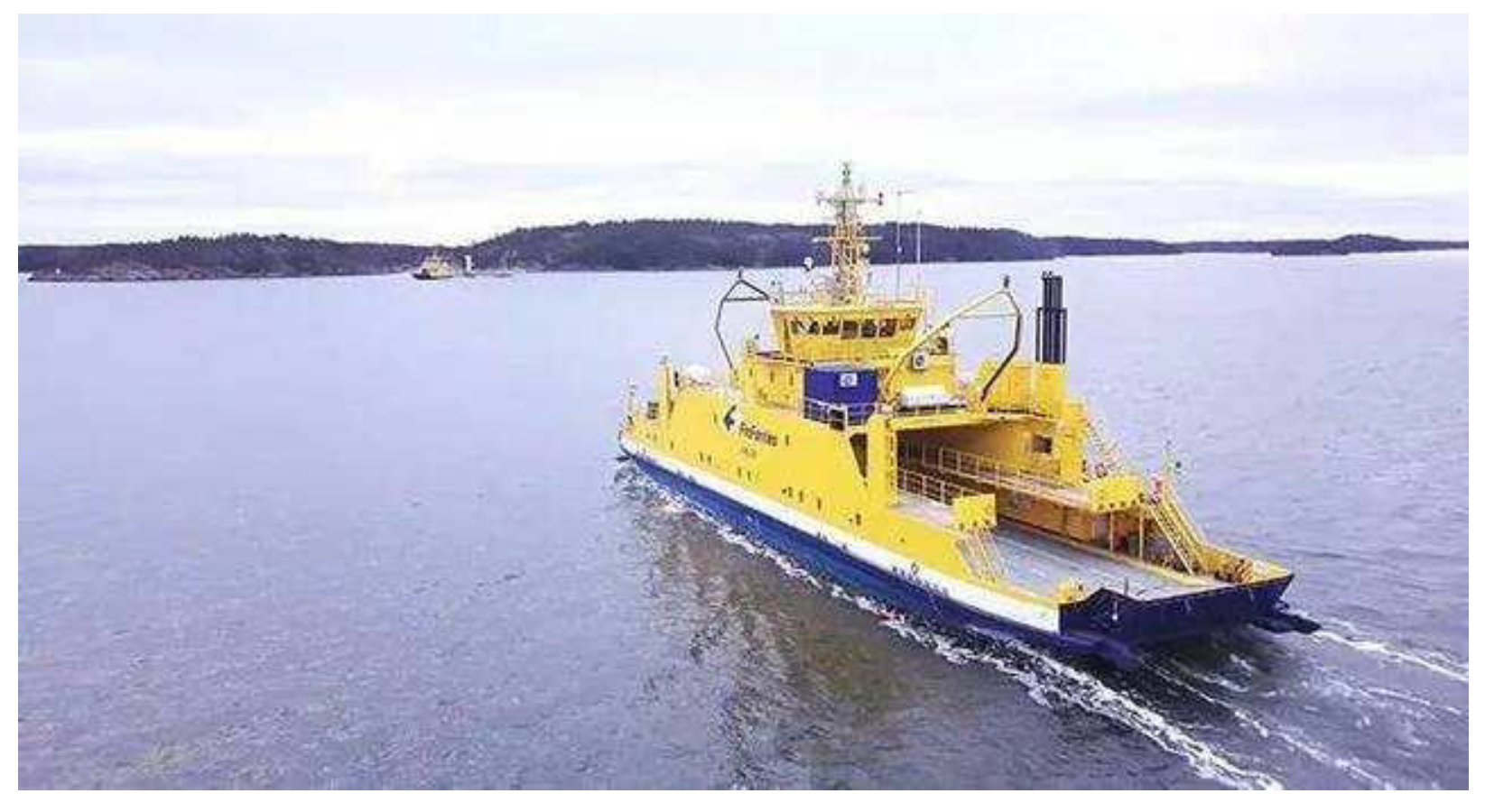
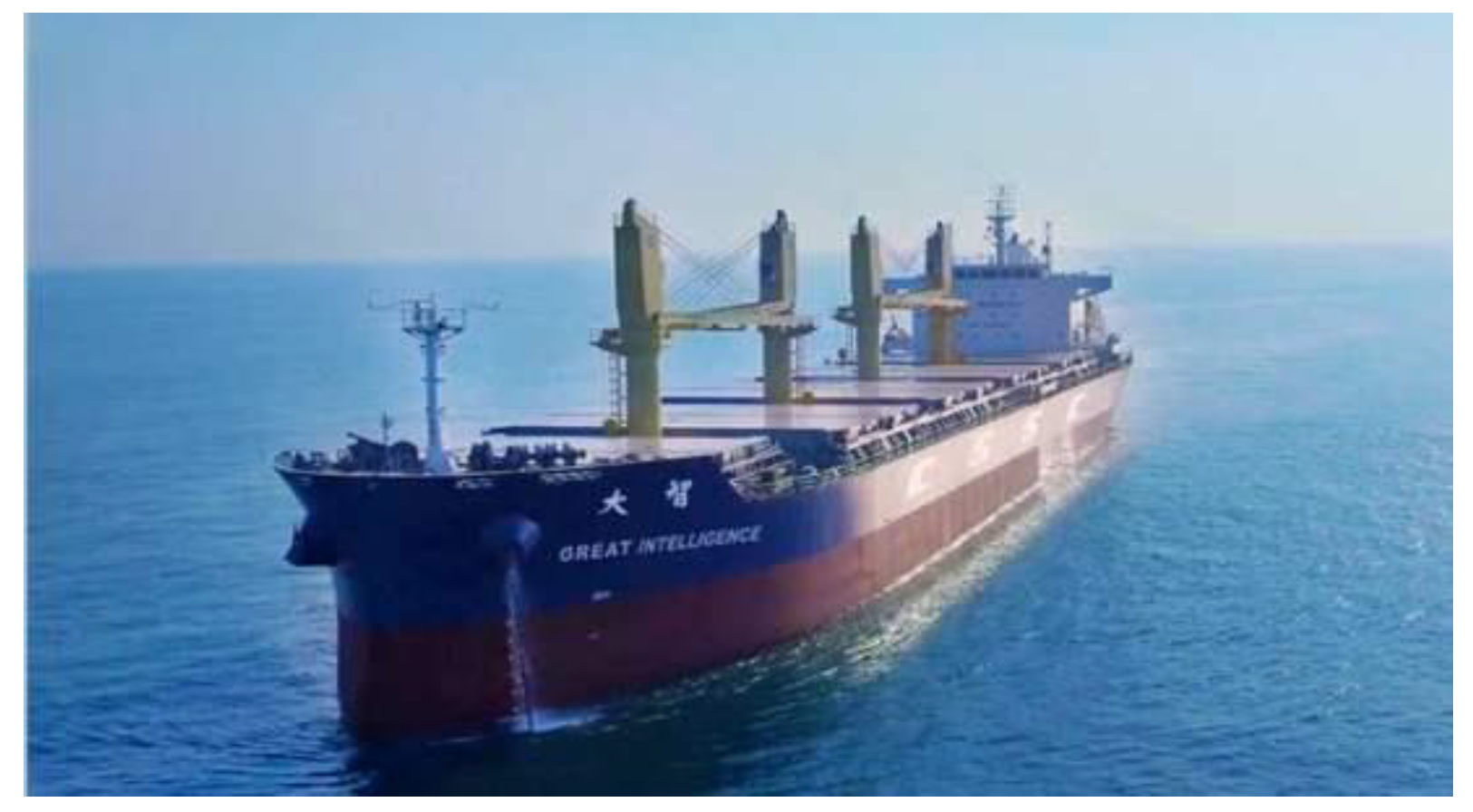
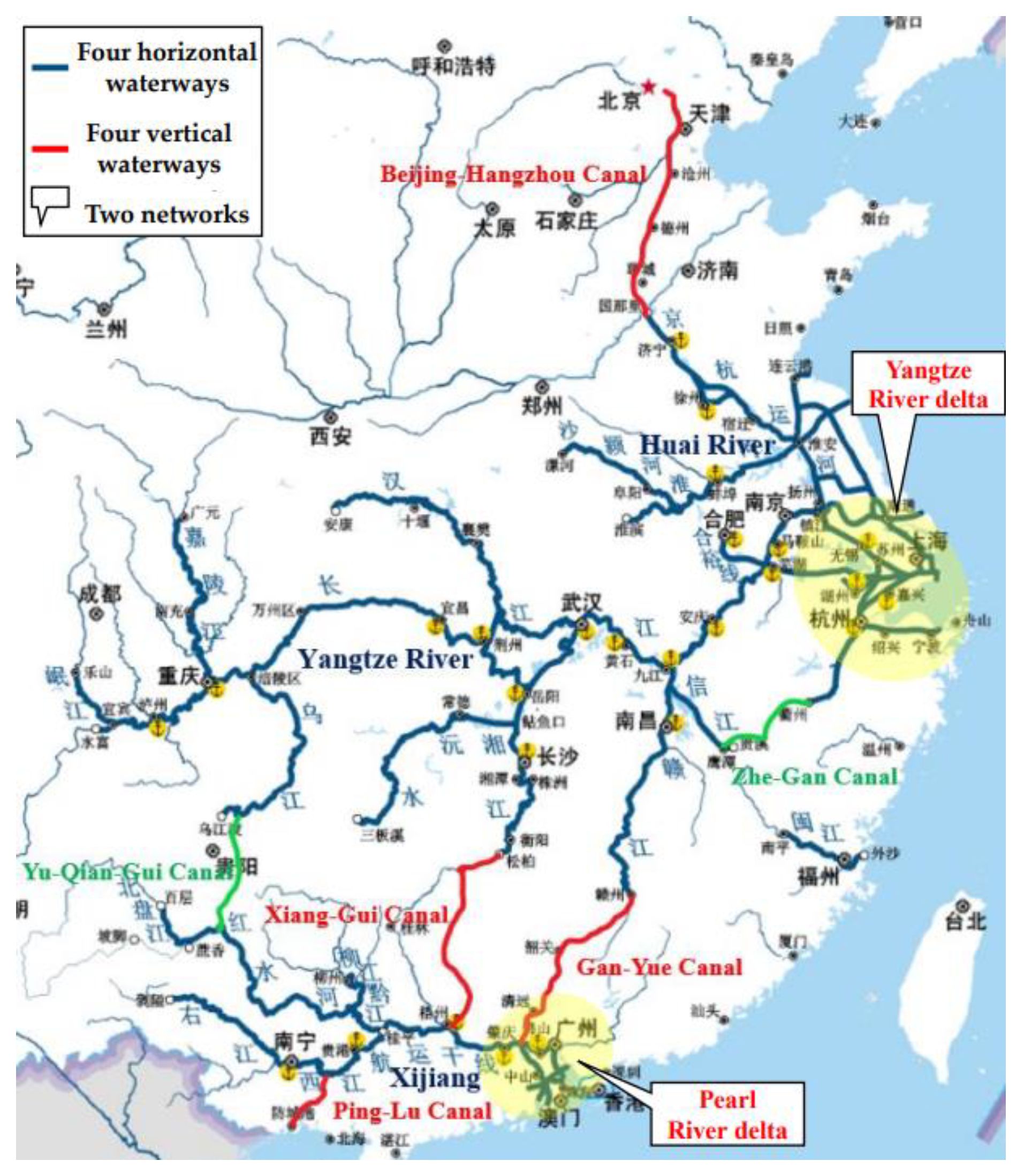




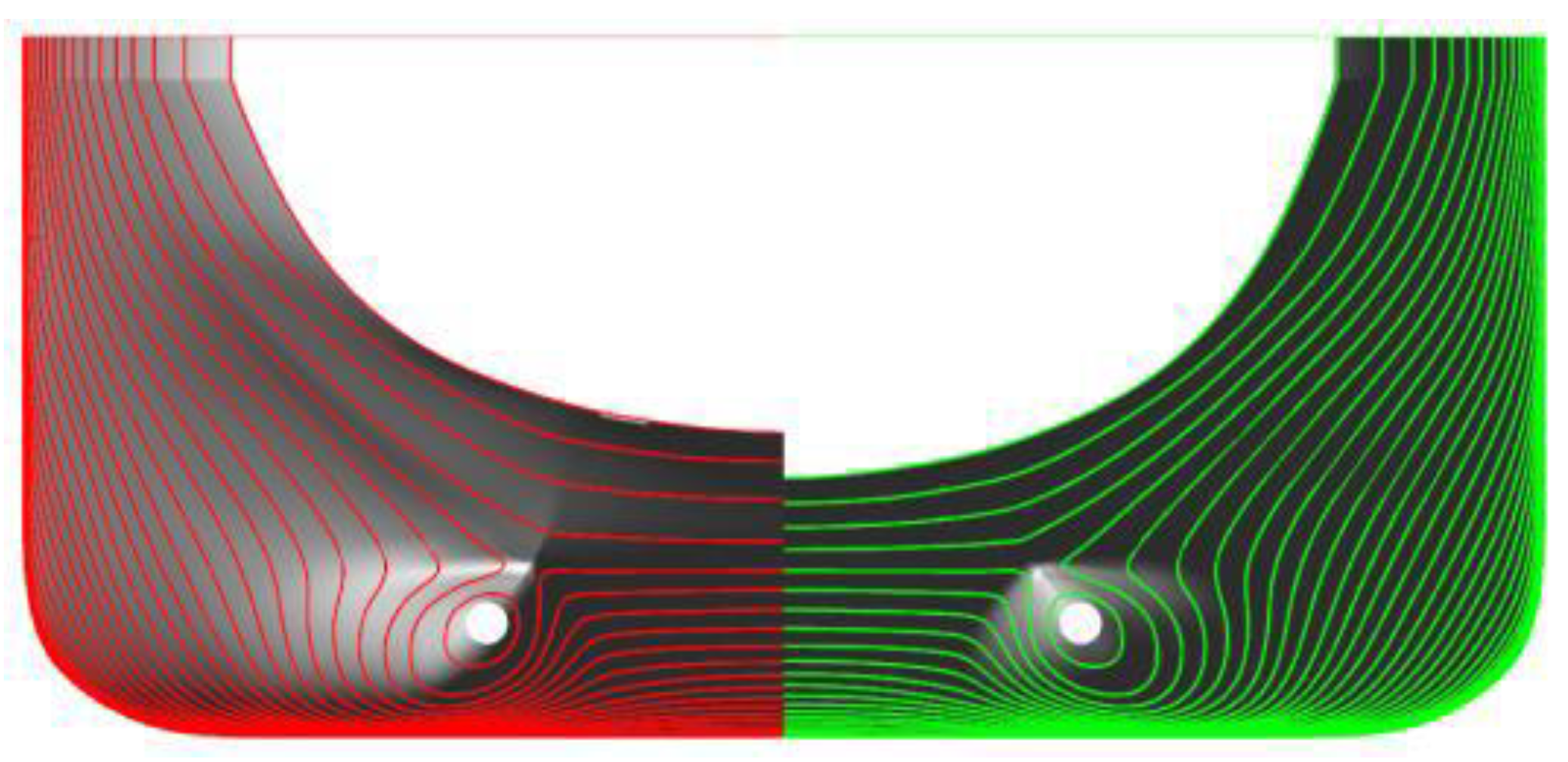

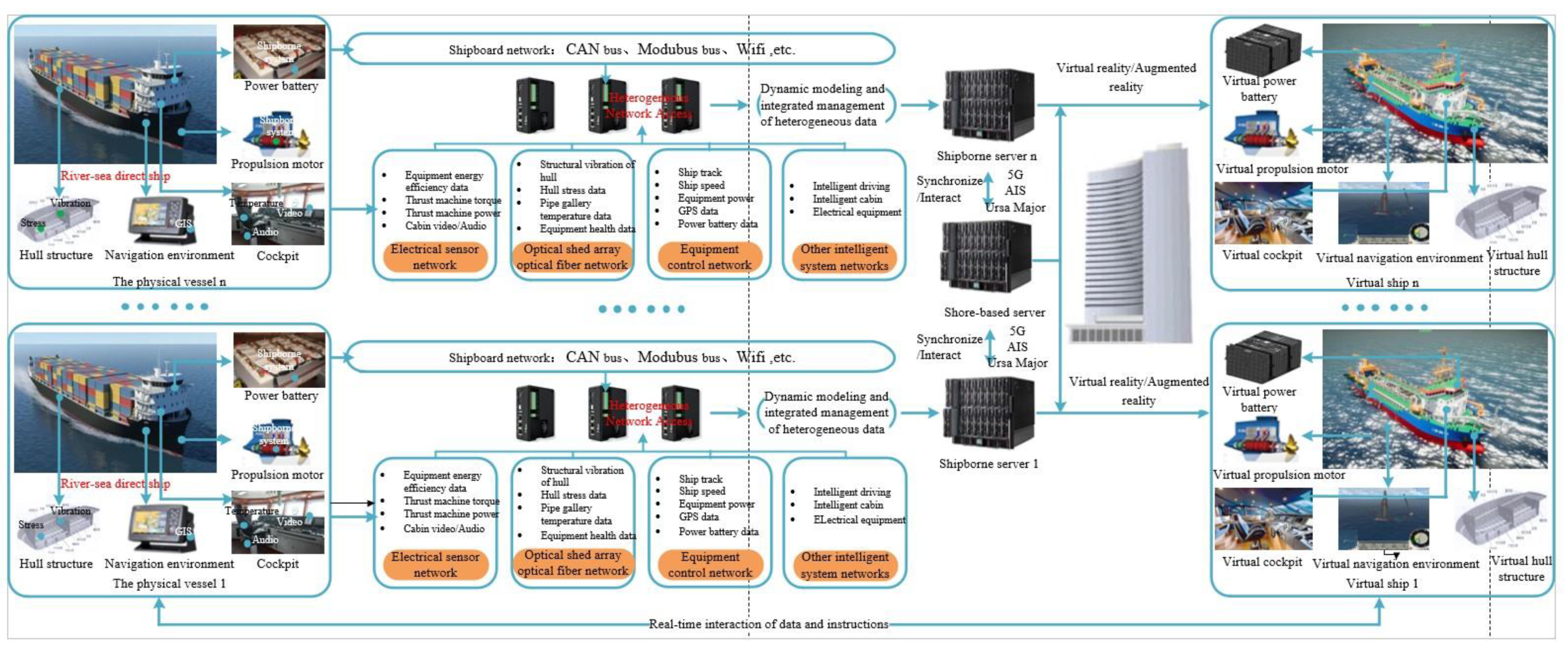
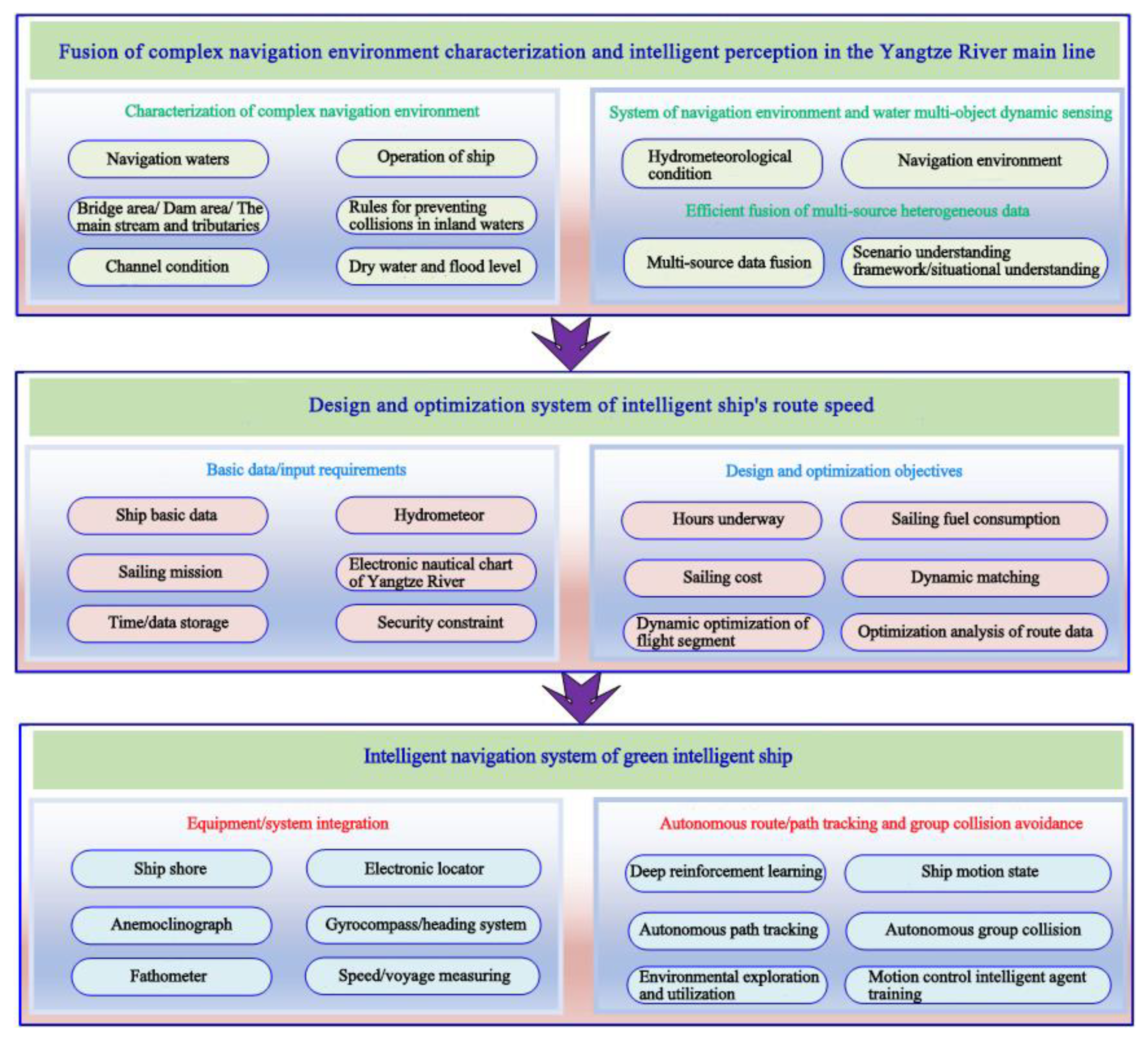

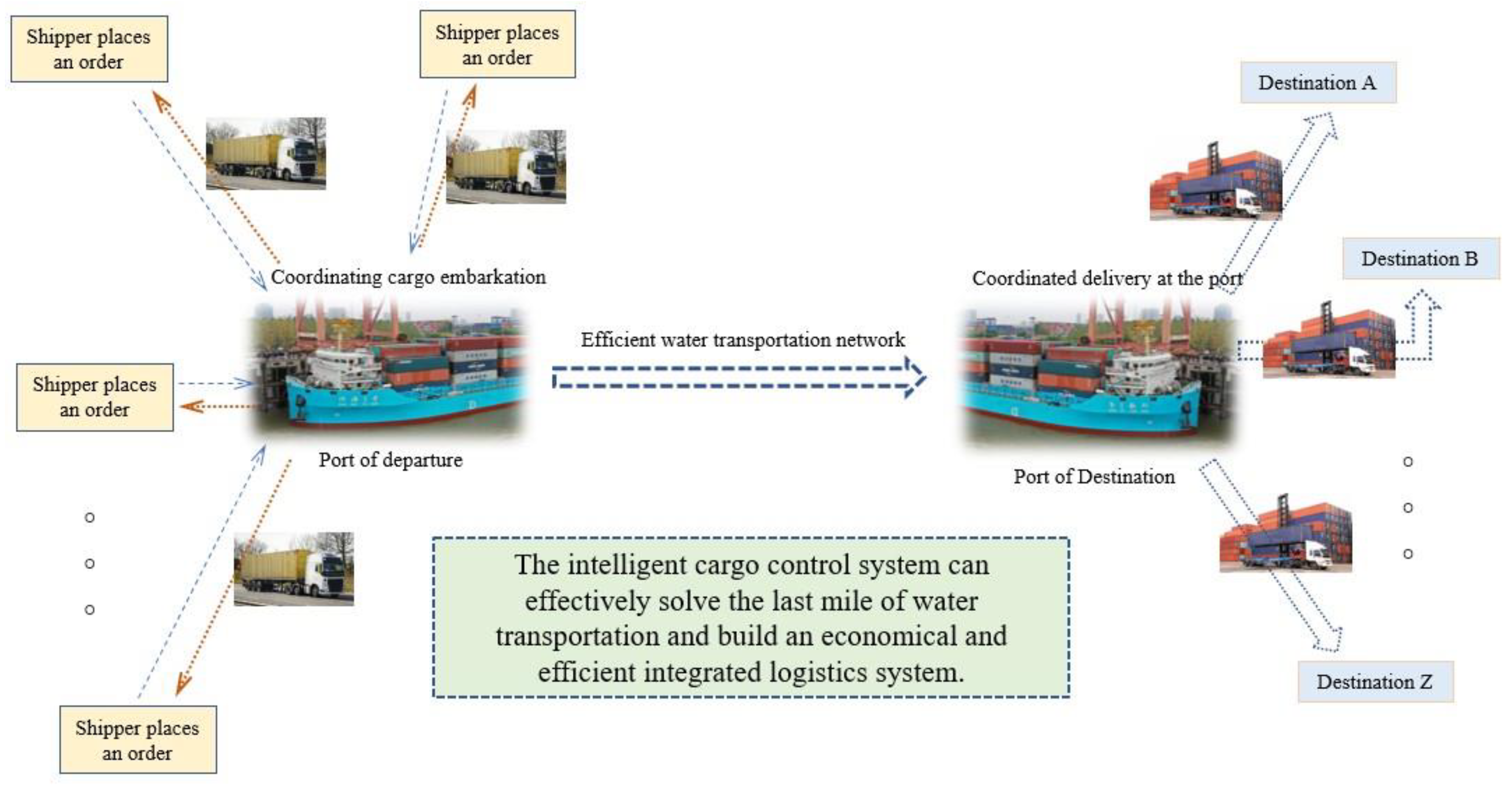
| Vs (kn) | Bulbous Bow | Forward Bow | Watermelon Bow | Vertical Bow |
|---|---|---|---|---|
| 9.0 | 3.139 | 3.214 | 3.342 | 3.139 |
| 10.0 | 3.156 | 3.260 | 3.363 | 3.125 |
| 10.5 | 3.190 | 3.268 | 3.400 | 3.221 |
| 11.0 | 3.256 | 3.339 | 3.517 | 3.322 |
Disclaimer/Publisher’s Note: The statements, opinions and data contained in all publications are solely those of the individual author(s) and contributor(s) and not of MDPI and/or the editor(s). MDPI and/or the editor(s) disclaim responsibility for any injury to people or property resulting from any ideas, methods, instructions or products referred to in the content. |
© 2024 by the authors. Licensee MDPI, Basel, Switzerland. This article is an open access article distributed under the terms and conditions of the Creative Commons Attribution (CC BY) license (https://creativecommons.org/licenses/by/4.0/).
Share and Cite
Pei, Z.; Kang, Y.; Long, F. Research and Development of Inland Green and Smart Ship Technologies in China. Appl. Sci. 2024, 14, 2316. https://doi.org/10.3390/app14062316
Pei Z, Kang Y, Long F. Research and Development of Inland Green and Smart Ship Technologies in China. Applied Sciences. 2024; 14(6):2316. https://doi.org/10.3390/app14062316
Chicago/Turabian StylePei, Zhiyong, Yuhan Kang, and Fei Long. 2024. "Research and Development of Inland Green and Smart Ship Technologies in China" Applied Sciences 14, no. 6: 2316. https://doi.org/10.3390/app14062316
APA StylePei, Z., Kang, Y., & Long, F. (2024). Research and Development of Inland Green and Smart Ship Technologies in China. Applied Sciences, 14(6), 2316. https://doi.org/10.3390/app14062316






